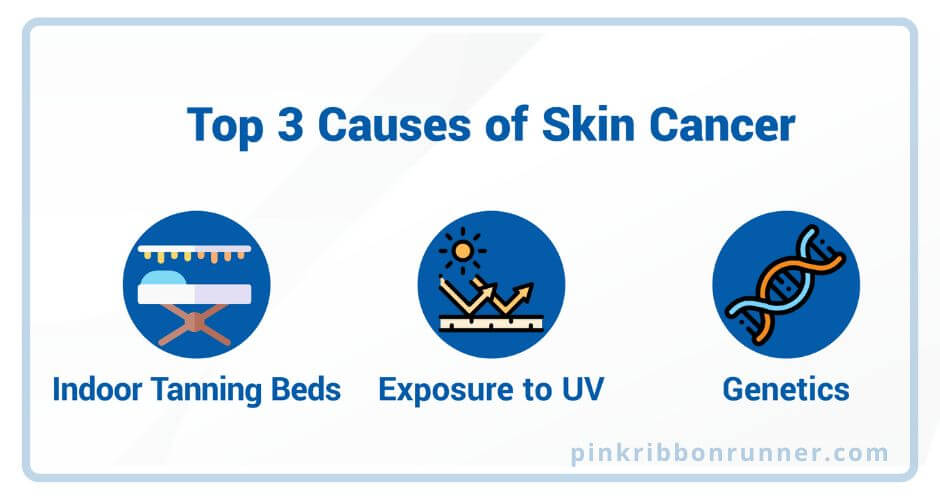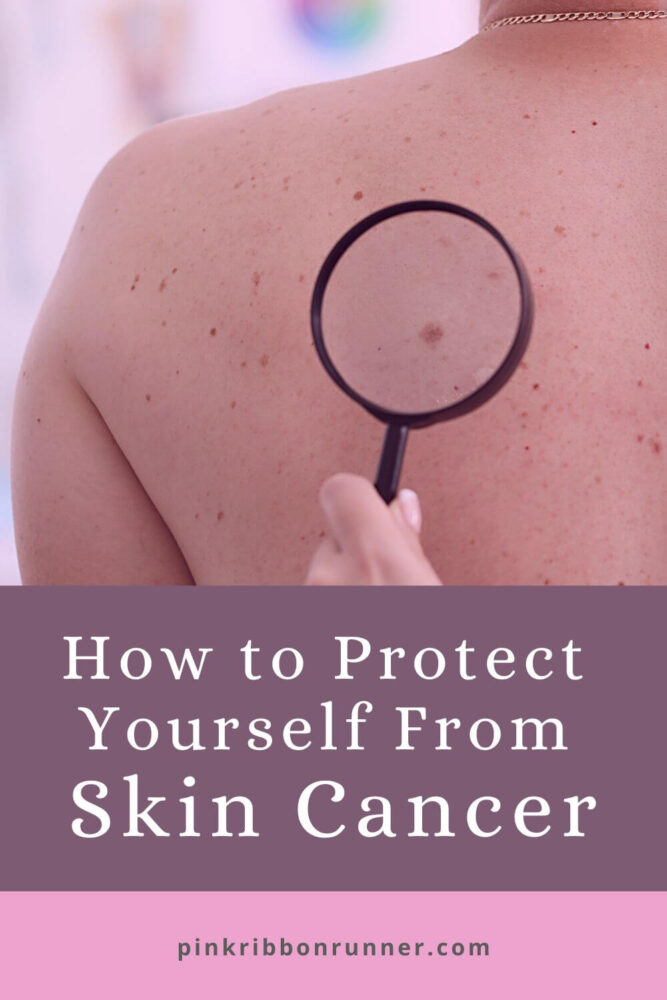How to Protect Yourself From Skin Cancer
Skin cancer is one of the most commonly diagnosed forms of cancer worldwide. It can have serious implications for individuals who are affected. With the right precautions and knowledge of how to protect yourself, you can reduce your risk of developing skin cancer. This article, written by a guest medical author for Pink Ribbon Runner, will provide helpful information on how to minimize your risk by identifying its causes, as well as tips on how to prevent skin cancer.

How You Can Protect Against Skin Cancer
Skin cancer is on the rise amongst the U.S population. More people in the U.S are diagnosed with skin cancer versus all other types of cancer.
Non-melanoma skin cancers (basal and squamous cell carcinoma) account for the majority of skin cancer cases. Despite the high numbers, these cancers have a survival rate of 93% with early detection. Similarly, even the deadliest form of skin cancer, melanoma, has a 99% survival rate if detected early.
When it comes to overcoming skin cancer, early detection is key. Read on to understand more about each skin cancer type and how to perform a skin self-exam.
What are the 3 Main Causes of Skin Cancer?
The top reason for skin cancer is sun exposure, which is followed by use of tanning beds and hereditary causes.

Sun Exposure & Skin Cancer:
Skin cancer occurs in people who are exposed to the sun’s ultraviolet (UV) rays for prolonged periods of time. The harmful effects of sun exposure builds up over time. Every time a person gets a sunburn, skin cells are damaged. The damage accumulates with time and increases the risk of skin cancer.
Tanning Beds & Skin Cancer:
Studies have confirmed that the use of tanning beds can significantly increase the risk of cancer. The International Agency for Research on Cancer, a World Health Organization affiliate, lists ultraviolet (UV) tanning equipment in Group 1, a list of substances that cause cancer.
Indoor tanning beds generate more UV radiation than the sun. Their use is directly related to skin cancer.
Genetics & Skin Cancer:
Certain people have a genetic predisposition to skin cancer. People with fair skin, especially those with red hair, are at higher risk of developing both non-melanoma and melanoma skin cancers. Individuals with a family history are also more likely to develop one of these illnesses.
What are the 3 Most Common Types of Skin Cancer?
1. Basal Cell Carcinoma
Basal cell carcinoma affects more individuals than lung, breast, and prostate cancer combined, with an estimated 3.3 million cases diagnosed in the United States each year.
This type of skin cancer occurs due to the abnormal proliferation of basal cells, which begins at the base of the skin’s uppermost layer. Basal cell carcinoma is common in regions of the body that are frequently and directly exposed to sunlight, such as the head and neck.
One of the first indications of cancer is a white, waxy lump or a brown, scaly patch on sun-exposed areas. It can be frequently misdiagnosed as a “pimple,” however this “pimple” does not go away and will frequently bleed with minimal damage.
The most common treatment option is surgery. When identified early, the prognosis for basal cell carcinoma is often quite good, with most patients recovering completely.
2. Squamous Cell Carcinoma
The second most common type in the U.S. is squamous cell carcinoma, which accounts for approximately one million cases yearly.
Squamous cells, like basal cells, are derived from the epidermis, which is the top layer of the skin. Squamous cell carcinoma is caused by cumulative UV (ultraviolet) exposure to cells. This affected skin can resemble red crusty sores.
While most squamous cell carcinomas have a favorable prognosis, the disease needs to be detected early to minimize deeper spread.
3. Melanoma
Despite being less common, melanoma is more aggressive than basal cell carcinoma and squamous cell carcinoma. Melanoma skin cancers can occur anywhere on the body, including places that are not normally exposed to the sun. Because this type of cancer can extend beyond the skin to other body parts, early detection and treatment are critical.
When it comes to skin cancer, early detection is crucial. Self-exams of the skin are advised because knowing how the skin feels and appears will help spot changes as soon as they occur. A monthly head-to-toe skin self-examination is recommended especially for those at high risk.
Read more: What You Need to Know About Melanoma

The A-B-C-D-E Rule of Skin Self-Exams
Regular skin self-exams can aid in the early detection of skin cancer. Skin inspections should be done monthly to detect any bleeding or change in the lesions. When it comes to basal or squamous cell carcinoma, look for any reoccurring spots on your skin. These patches can bleed with a slight touch, but do not cause pain.
The ABCDE rule for skin cancer is a useful acronym for identifying possible skin cancers. It guides you on what to look for while inspecting your skin.
A is for Asymmetrical
Noncancerous moles are almost often symmetrical, while the cancerous ones tend to be asymmetrical. This means that one half of the spot is unlike the other.
B is for Border
A malignant spot or mole may be uneven or fuzzy, which might be pink or red in color. A non-cancerous spot or mole will usually have well-defined borders.
C is for Color
A typical mole is uniformly pigmented, typically a single shade of brown. A malignant spot may not be uniform in color. The color of the spot will vary from one location to the next, with hues of tan, brown, or black.
D is for the Diameter
If the mole is larger than 1/4 inch (6 millimeters), which is the size of a pencil eraser, it could be an indication of skin cancer. It is recommended that larger moles or spots are checked by your doctor.
E is for Evolving
Moles or spots that are changing or evolving can be a symptom of skin cancer. Melanoma spots may develop, and change color, or shape. They might also begin to itch or bleed. Noncancerous (benign) patches and moles tend not to change in appearance.
How to protect your body from skin cancer
Most skin cancers occur due to excessive exposure to ultraviolet (UV) rays. To reduce the chances of developing skin cancer, protect your skin from the sun’s UV radiation and artificial forms of UV exposure such as tanning beds and sunlamps.
Practice Sun Safety
UV ray protection is crucial all year round, not just in the summer. UV rays can penetrate the skin even on cloudy or cool days because they reflect off surfaces such as water, cement, sand, and snow.
Here are a few ways to protect your body from the sun:
- Stay in the shade as much as possible
- Don’t wear clothing that exposes your arms or leg
- Wear a hat
- Wear sunglasses
- Make use of broad-spectrum sunscreen with an SPF of 30 or higher and reapply every two hours if still out in the sun.
Avoid Indoor Tanning
Indoor tanning exposes users to high levels of UV radiation, which is a known cause of cancer. A tan doesn’t signal good health. When UV rays penetrate the skin’s inner layer, it produces more melanin (a pigment that produces body color – causing the skin to darken and ‘tan”). It progresses to the skin’s outer layers and appears as a tan. Any change in skin tone following UV exposure (whether a tan or a burn) indicates injury rather than health.

The Takeaway
Early detection is critical in skin cancer. The American Academy of Dermatology recommends that everyone does regular skin self-exams to look out for signs of skin cancer. Follow the ABCDE rule and stay safe. And, if you spot something suspicious, it is always recommended to consult with your doctor.
Read More Ways to Reduce Your Risk of Cancers
Top 10 Easy Lifestyle Hacks to Significantly Reduce Cancer Risk









